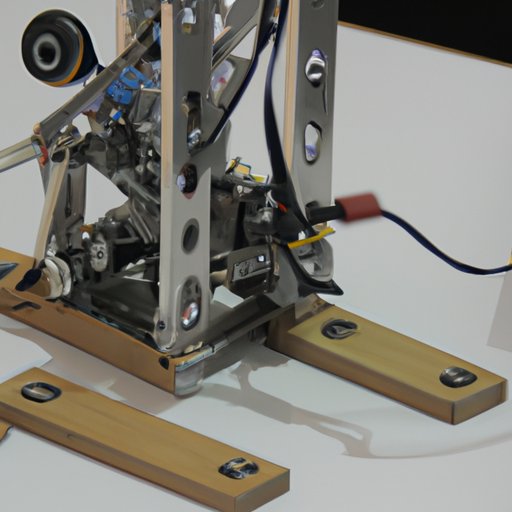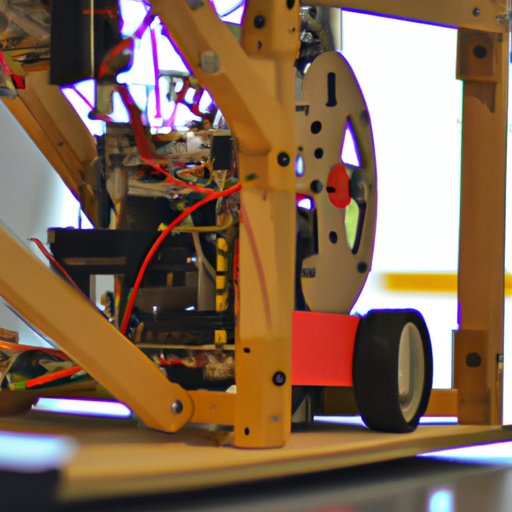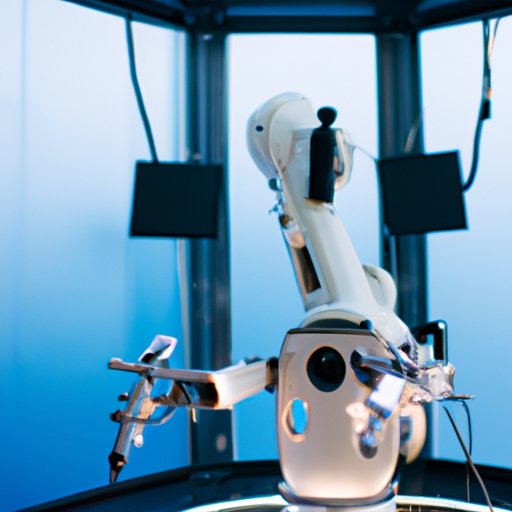Introduction
The da Vinci® robot is a state-of-the-art surgical system developed by Intuitive Surgical Inc. The system was designed to assist surgeons in performing minimally invasive surgical procedures with greater accuracy and precision. The da Vinci robot has revolutionized the field of robotic surgery and continues to be used in a variety of medical procedures around the world.
A Step-by-Step Guide to the Da Vinci Robot
At its core, the da Vinci robot consists of four key components: an ergonomic console, three robotic arms, endoWrist instruments, and a 3D visualization system. Each component plays an integral role in the operation of the robot, allowing it to perform complex surgical procedures with minimal risk to the patient.
The console is the control center for the da Vinci robot, where the surgeon sits and operates the system’s robotic arms. The console is equipped with two joysticks and several foot pedals that allow the surgeon to precisely manipulate the robot’s movements. The console also features a high-definition 3D imaging system that provides a detailed view of the surgical site.
The three robotic arms of the da Vinci robot are connected to the console via a series of cables. These arms are what give the robot its dexterity and range of motion. They are capable of making small, precise movements that would be impossible for a human surgeon to replicate.
The endoWrist instruments are attached to the ends of the robotic arms. These instruments are specially designed to mimic the movements of the human wrist, allowing the robot to make delicate, intricate movements that would be difficult or impossible to perform manually. The endoWrist instruments come in a variety of sizes and shapes, allowing the surgeon to select the best tool for the job.
The da Vinci robot’s 3D visualization system is what allows the surgeon to get a detailed view of the surgical site. This system uses a combination of cameras and computers to provide an immersive, three-dimensional image of the area being operated on. This allows the surgeon to better assess the situation and plan their actions accordingly.

Exploring the Mechanics Behind the Da Vinci Robot
The da Vinci robot is powered by a sophisticated set of technologies. At its heart is the three-dimensional visualization system, which enables the surgeon to get an up-close, detailed view of the surgical site. This system uses a combination of cameras and computers to create a three-dimensional image of the area being operated on.
The endoWrist instruments are the tools that the robot uses to perform the actual surgery. These instruments are designed to mimic the movements of the human wrist, allowing the robot to make delicate, intricate movements that would be difficult or impossible to perform manually. The endoWrist instruments come in a variety of sizes and shapes, allowing the surgeon to select the best tool for the job.
The robotic arms of the da Vinci robot are what give the system its dexterity and range of motion. The arms are connected to the console via a series of cables and are capable of making small, precise movements that would be impossible for a human surgeon to replicate.

How the Da Vinci Robot Revolutionized Surgery
The da Vinci robot has had a profound effect on the field of robotic surgery. Its enhanced precision and improved control have allowed surgeons to perform complex procedures with minimal risk to the patient. The robot’s reduced trauma has also made it possible for patients to recover faster and more completely from their operations.
The da Vinci robot’s enhanced precision means that surgeons can perform delicate procedures with greater accuracy than ever before. This increased precision allows surgeons to operate on areas of the body that were previously inaccessible or too risky to approach. Additionally, the robot’s improved control gives surgeons greater control over the movements of the instruments, allowing them to perform more complex tasks with confidence.
The da Vinci robot’s reduced trauma means that patients can recover faster and more completely from their operations. The robot’s smaller incisions reduce the chance of infection and other post-operative complications. Additionally, the robot’s improved control allows surgeons to operate with greater precision, reducing the amount of tissue damage during the procedure.
The Intricacies of the Da Vinci Robot
Despite its impressive capabilities, the da Vinci robot is not without its challenges. Its programming and maintenance can be complicated, and its motion tracking can be difficult to perfect. Additionally, the robot’s safety features must be carefully monitored to ensure that the system is functioning properly.
Programming and maintenance of the da Vinci robot can be time consuming and complicated. The robot’s software must be regularly updated and maintained to ensure that it is functioning correctly. Additionally, the robot’s motion tracking must be closely monitored to ensure that the system is operating smoothly and accurately.
The da Vinci robot’s safety features are designed to protect both the patient and the surgeon. The robot is equipped with sensors that detect any sudden movements that could potentially cause harm to the patient. Additionally, the robot is programmed to automatically shut down if any potential hazards are detected.

Unveiling the Inner Workings of the Da Vinci Robot
The da Vinci robot can be used to perform a wide range of surgical procedures. Its intuitive interfaces allow surgeons to quickly and easily program the robot for each procedure. Additionally, its artificial intelligence capabilities enable the robot to anticipate the surgeon’s needs and adjust its movements accordingly.
The da Vinci robot is capable of performing a variety of complex surgical procedures. Its intuitive interfaces allow surgeons to quickly and easily program the robot for each procedure. Additionally, the robot’s artificial intelligence capabilities enable it to anticipate the surgeon’s needs and adjust its movements accordingly.
The da Vinci robot is also capable of performing a variety of minimally invasive procedures. Its miniature instruments allow surgeons to access hard-to-reach areas of the body with minimal trauma to the patient. Additionally, the robot’s enhanced precision and improved control enable surgeons to perform delicate procedures with greater accuracy than ever before.
A Comprehensive Overview of the Da Vinci Robot
The da Vinci robot has revolutionized the field of robotic surgery and continues to be used in a variety of medical procedures around the world. Its enhanced precision and improved control have allowed surgeons to perform complex procedures with minimal risk to the patient. Additionally, its reduced trauma has enabled patients to recover faster and more completely from their operations.
Despite its many advantages, the da Vinci robot has its share of challenges. Its programming and maintenance can be complicated, and its motion tracking can be difficult to perfect. Additionally, the robot’s safety features must be carefully monitored to ensure that the system is functioning properly.
Looking ahead, the da Vinci robot will continue to evolve and become even more advanced. Its integration with artificial intelligence and computer vision technologies will enable it to perform increasingly complex tasks with greater precision and accuracy than ever before. Additionally, its use in new and innovative surgical procedures will further revolutionize the field of robotic surgery.
Understanding the Technology Behind the Da Vinci Robot
At its core, the da Vinci robot is powered by a combination of computer vision, automation, and robotics technologies. Computer vision allows the robot to “see” the surgical site in three dimensions, enabling it to make precise movements. Automation allows the robot to anticipate the surgeon’s needs and adjust its movements accordingly. Finally, robotics enables the robot to make delicate, intricate movements that would be impossible for a human surgeon to replicate.
The da Vinci robot is an impressive example of how technology can be harnessed to improve medical care. Its enhanced precision and improved control have allowed surgeons to perform complex procedures with minimal risk to the patient. Additionally, its reduced trauma has enabled patients to recover faster and more completely from their operations.
Conclusion
The da Vinci robot has revolutionized the field of robotic surgery and continues to be used in a variety of medical procedures around the world. Its enhanced precision and improved control have allowed surgeons to perform complex procedures with minimal risk to the patient. Additionally, its reduced trauma has enabled patients to recover faster and more completely from their operations.
The da Vinci robot is powered by a combination of computer vision, automation, and robotics technologies. Its intuitive interfaces allow surgeons to quickly and easily program the robot for each procedure. Additionally, its artificial intelligence capabilities enable the robot to anticipate the surgeon’s needs and adjust its movements accordingly.
The da Vinci robot has proven to be a powerful tool for surgeons, offering a level of precision and control that was previously unimaginable. As the technology continues to evolve, it will undoubtedly continue to revolutionize the field of robotic surgery and improve patient outcomes.
(Note: Is this article not meeting your expectations? Do you have knowledge or insights to share? Unlock new opportunities and expand your reach by joining our authors team. Click Registration to join us and share your expertise with our readers.)
